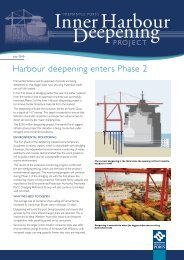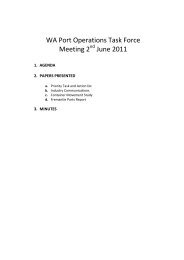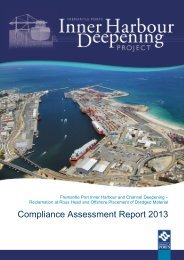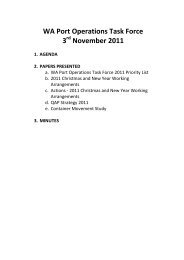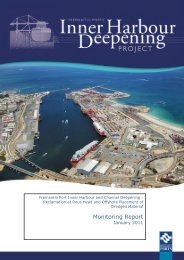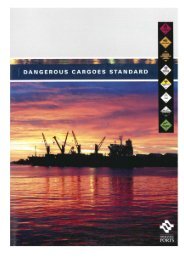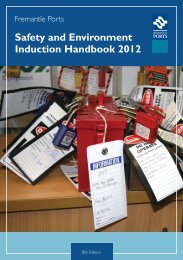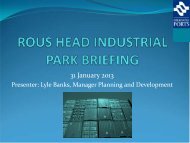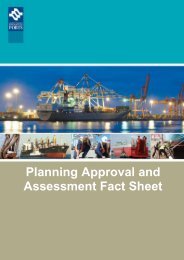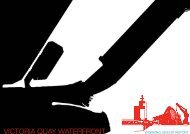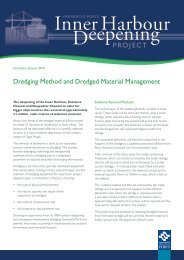Fremantle Port Inner Harbour and Channel ... - Fremantle Ports
Fremantle Port Inner Harbour and Channel ... - Fremantle Ports
Fremantle Port Inner Harbour and Channel ... - Fremantle Ports
- No tags were found...
You also want an ePaper? Increase the reach of your titles
YUMPU automatically turns print PDFs into web optimized ePapers that Google loves.
Project 1Project 1 aimed to generate a broad substrate classification (Tier 1 classification) to extractinformation based on the classes outlined in Table 2.Table 2: Tier 1 marine substrate mapping classesTier 1ClassesLightSubstrateDarkSubstrateOpen WaterTurbid WaterDescriptionIndicative of s<strong>and</strong>y substrates inshallow areasIndicative of biotic substrates <strong>and</strong>abiotic substrates such as Boulders,Rock, Pebbles, CobblesAll areas where water depthprevents the classification of the seafloorAll areas where suspended sediment<strong>and</strong> plumes prevents theclassification of the sea floor.Limitations or assumptionsWater depth prevents classification beyond15mUncertainty of class with where water depthsare between 15-20m. Increased uncertaintywhere water depths are greater than 20m.Some variability can still be detected basedon context, field data integration, texture ofimagery.Areas deeper than 15m water depth wheresea-floor variability cannot be detecteddespite analysis of imagery context, texture<strong>and</strong> field data integration.Areas across the site where turbidity hasimpacted the imagery.Segmentation algorithms were tested <strong>and</strong> applied to separate objects of homogeneity based onstatistical relationships within the imagery. Classification algorithms were also trialled, but due tolimitations with water column depths, it was deemed necessary to export the statistical segments withonly the light substrate at depths shallower than 15m. All depths greater than 15m were required to bemanually classified based on the statistical objects <strong>and</strong> field data inputs.As part of the Tier 1 substrate mapping in Project 1, areas that could not be identified due to theexistence of turbidity plumes or at depths greater than 15 m were masked as either Turbid Water orOpen Water to distinguish regions that were not able to be processed further.Project 2Project 2 aimed to generate a more detailed substrate classification (Tier 2 classification) to extractinformation based on the classes outlined in Table 3. The segments exported in Project 1 were usedas a base to inform the manual attribution of shape context <strong>and</strong> texture in combination with field data.Specialists in Satellite Imagery <strong>and</strong> Geospatial Solutions | Commercial in confidence Page | 6



